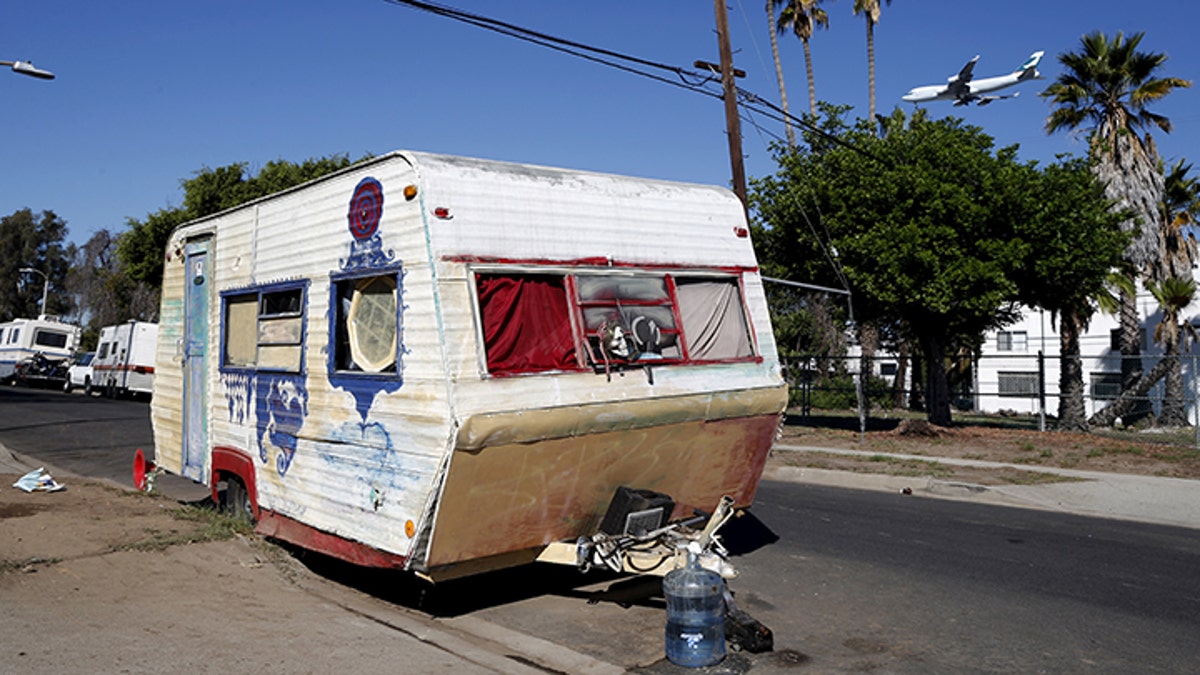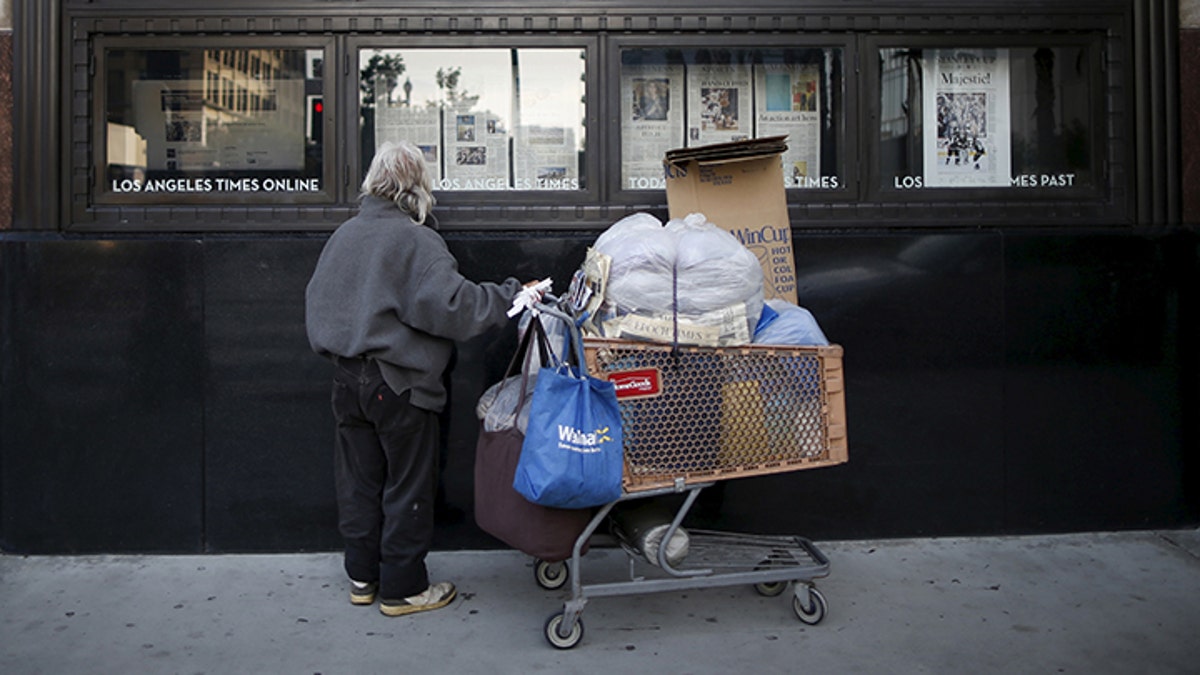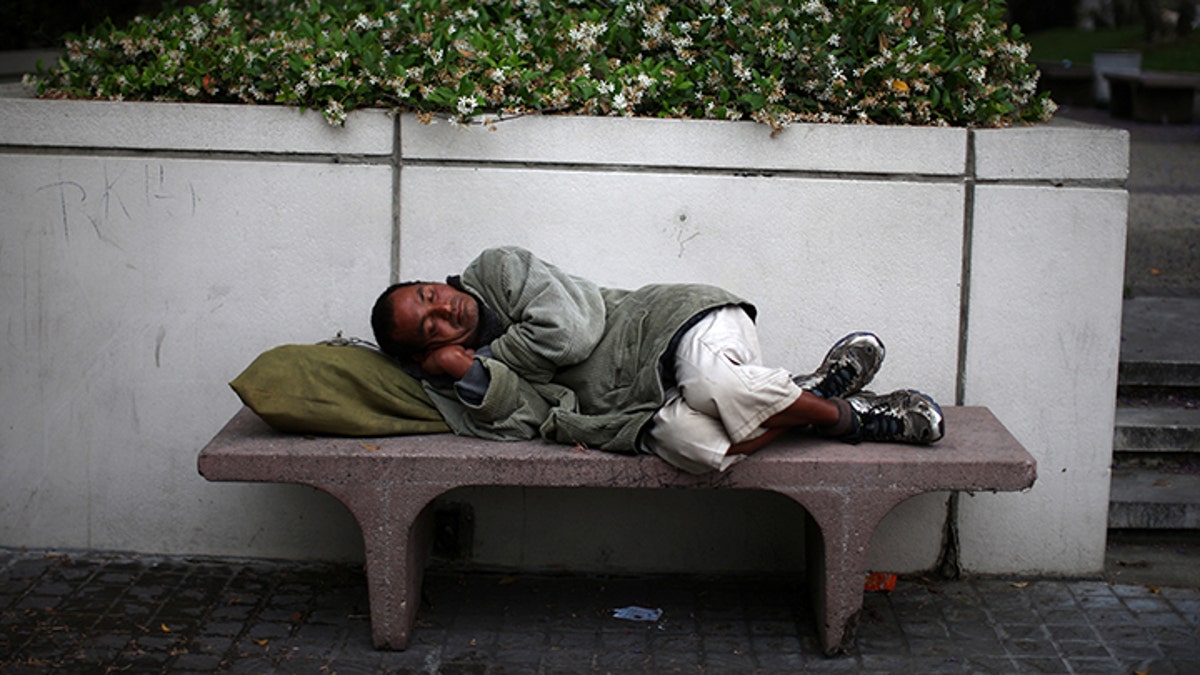
Bob Billeter combines a field of barley near Kalispell, Mont., Tuesday, Aug. 20, 2002. Billeter said he hopes to finish the 50-acre field and have the straw baled before expected wet weather moves into the area. (AP Photo/Daily Inter lake, Robin Loznak) (AP2002)
Liberal California and conservative Texas are different in many ways – including their poverty rates.
California’s poverty rate is 20.4 percent and the Texas rate is only 14.7 percent, based on the Supplemental Poverty Measure, which accounts for the regional cost of living, out-of-pocket medical expenses and other items.

A plane flies over a homeless motor home and tent encampment near LAX airport in Los Angeles, California. (homeless02)
Why the dramatic difference in poverty between California and Texas – proportionately 38.8 percent higher in the Golden State, and affecting the lives of millions of people? And what can we as a nation learn from the success of Texas and the failure of California to hold down their poverty rates?
Three big factors are responsible for California having more poor people and Texas having fewer as a portion of their state populations:
- California has high state and local tax rates, while the rates in Texas are low.
- California has a generous welfare system that acts as a disincentive to work, while Texas incentivizes people to get jobs.

A homeless man reads the Los Angeles Times in the window of the building of Los Angeles Times newspaper, in Los Angeles, California (REUTERS/Lucy Nicholson)
- And California’s many burdensome regulations raise the cost of living and act as roadblocks to development, while inflating housing costs. So a family needs to have a higher income to get out of poverty in California than it needs in Texas.
California has the nation’s highest marginal state income tax rate – 13.3 percent. Texas is one of seven states without a state income tax. A ranking of all state and local taxes for median income households in every state shows that California ranks No. 8, while Texas comes in at No. 30 on the list.
The higher taxes are, the less money families have. And higher taxes mean employers have less money to hire new workers and raise the salaries of workers already on their payrolls.
California has a generous and costly safety net that discourages work, while raising state spending and the need for high taxes.
Some 1 out of 3 Americans who receive federally qualified welfare payments –Temporary Assistance for Needy Families – are Californians. And California has expanded Medicaid (called Medi-Cal there), to cover 13.5 million people. About one-third of state residents are enrolled in the health insurance program for the poor funded by the federal government and the state.
On the jobs front, California’s environmental and energy policies have created costly and burdensome regulations that have accelerated the shift of manufacturing and other jobs out of the state and out of the country to China and other nations.
When combined with generous welfare payments, this has resulted in fewer adults participating in the workforce in California than the national average. If Californians 16 and older worked at the same rate as they do in Texas, 550,000 more Californians would be earning a paycheck and many of them would be self-sufficient instead of dependent on government.

A man sleeps on a bench in downtown Los Angeles, California, May 31, 2017 (REUTERS/Lucy Nicholson)
As for affordable housing, California lawmakers know they have a problem. But their proposals to fix it are more of the same: bigger government, more borrowing, and higher taxes to pay for more government housing – while telling homebuilders what to build.
Instead of continuing on this course, elected officials should fix the terrible state of property rights in California. After New Jersey and Maryland, California is the third least-free state when it comes to housing regulation.
Development fees, global warming carbon dioxide concerns, restrictive zoning, and other barriers act to create a massive artificial scarcity of housing in California. This pushes the cost of a home beyond reach for the middle class, while making rent virtually impossible for the poor.
In sharp contrast, housing costs in Texas are far more affordable. While the average listing price for a home in California is nearly $698,000, the average listing price for a home in Texas is less than half that – $320,000.
California’s defenders claim that the Golden State provides a great deal for its diverse population. Only 52.5 percent of California residents are non-Hispanic whites or Asian – the two large racial or ethnic groups with above-average income in America – compared to 66 percent nationwide.
However, in Texas, only 47.4 percent of the population is made up of non-Hispanic whites or Asians. Using this metric, demographers would predict that Texas, not California, should have a higher poverty rate.
Clearly, the poverty reduction policy in California is badly broken.
I’m a former Republican member of the California state Assembly. I saw firsthand how big-spending Democrats in the state Legislature raised taxes and increased regulations with the intention of helping poor people – but wound up hurting them instead.
As the old saying goes: “The road to hell is paved with good intentions.”
In Texas, where I now live, small government, low taxes, and a regulatory environment that encourages job creation and economic growth have turned out to be a better way to hold down the poverty rate and create pathways to the middle class.
Other states and our national government should learn from the experience of California and Texas if they want to replace poverty with prosperity for more Americans.
